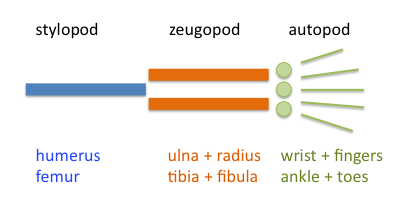|
Archipterygium Theory
Archipterygium (or ancient fin) is the concept of a primitive limb from which the limbs of tetrapod animals evolved. The idea was proposed by Karl Gegenbaur in 1878, sometimes termed the gill septum hypothesis and it consisted of a series of rays, one ray large with the remaining small ones attached to the sides of the large one. Gegenbaur based this idea on the fin of ''Ceratodus'' and its similarity to the gill-region in Elasmobranchs. He suggested that the pentadactyl limb of modern tetrapods was derived from one side of the archipterygium. Thomas Huxley Thomas Henry Huxley (4 May 1825 – 29 June 1895) was an English biologist and anthropologist specialising in comparative anatomy. He has become known as "Darwin's Bulldog" for his advocacy of Charles Darwin's theory of evolution. The stor ... examined the idea and argued against it. He suggested that the tetrapod limb or ''cheiropterygium'' differed in its origins from that of the lungfish and that the two may have dive ... [...More Info...] [...Related Items...] OR: [Wikipedia] [Google] [Baidu] |
Karl Gegenbaur
Karl Gegenbaur (21 August 1826 – 14 June 1903)"Karl Gegenbaur – Encyclopædia Britannica" (biography), ''Encyclopædia Britannica'', 2006, Britannica.coBritannica-KarlG was a German anatomist and professor who demonstrated that the field of comparative anatomy offers important evidence supporting of the theory of evolution. As a professor of anatomy at the University of Jena (1855–1873) and at the University of Heidelberg (1873–1903), Karl Gegenbaur was a strong supporter of Charles Darwin's theory of organic evolution, having taught and worked, beginning in 1858, with Ernst Haeckel, eight years his junior. Gegenbaur's book ''Grundzüge der vergleichenden Anatomie'' (1859; English translation ''Elements of Comparative Anatomy'' by Francis Jeffrey Bell, 1878) became the standard textbook, at the time, of evolutionary morphology (biology), morphology, emphasizing that structural similarities among various animals provide clues to their evolutionary history. Karl Gegenbaur ... [...More Info...] [...Related Items...] OR: [Wikipedia] [Google] [Baidu] |
Ceratodus
''Ceratodus'' (from el, κέρας , 'horn' and el, ὀδούς 'tooth') was a wide-ranging genus of extinct lungfish. Fossil evidence dates back to the Early Triassic. A wide range of fossil species from different time periods have been found around the world in places such as the United States, Argentina, Greenland, England, Germany, Egypt, Madagascar, China, and Australia.Agnolin, F. L., Mateus O., Milàn J., Marzola M., Wings O., Adolfssen J. S., & Clemmensen L. B. (2018). Ceratodus tunuensis, sp. nov., a new lungfish (Sarcopterygii, Dipnoi) from the Upper Triassic of central East Greenland. Journal of Vertebrate Paleontology. e1439834 ''Ceratodus'' is believed to have become extinct sometime around the beginning of the Eocene Epoch. The closest living relative of ''Ceratodus'' is thought to be the Queensland lungfish, ''Neoceratodus forsteri'', which means "new ''Ceratodus''" in Greek. Species * ''C. latissimus'' Agassiz, 1837 ( type) * ''C. eruciferus'' Cope, 1876 (''nom ... [...More Info...] [...Related Items...] OR: [Wikipedia] [Google] [Baidu] |
Thomas Henry Huxley
Thomas Henry Huxley (4 May 1825 – 29 June 1895) was an English biologist and anthropologist specialising in comparative anatomy. He has become known as "Darwin's Bulldog" for his advocacy of Charles Darwin's theory of evolution. The stories regarding Huxley's famous 1860 Oxford evolution debate with Samuel Wilberforce were a key moment in the wider acceptance of evolution and in his own career, although some historians think that the surviving story of the debate is a later fabrication. Huxley had been planning to leave Oxford on the previous day, but, after an encounter with Robert Chambers, the author of '' Vestiges'', he changed his mind and decided to join the debate. Wilberforce was coached by Richard Owen, against whom Huxley also debated about whether humans were closely related to apes. Huxley was slow to accept some of Darwin's ideas, such as gradualism, and was undecided about natural selection, but despite this he was wholehearted in his public support of D ... [...More Info...] [...Related Items...] OR: [Wikipedia] [Google] [Baidu] |
Francis Maitland Balfour
Francis (Frank) Maitland Balfour, known as F. M. Balfour, (10 November 1851 – 19 July 1882) was a British biologist. He lost his life while attempting the ascent of Mont Blanc. He was regarded by his colleagues as one of the greatest biologists of his day and Charles Darwin's successor. Life The younger brother of the politician Arthur Balfour, he was born at Edinburgh in Scotland. He attended Harrow School, where he tied with Arthur Evans, the future archaeologist of Knossos, for the Natural History Prize. George Griffith, a teacher at Harrow, encouraged and aided him in the pursuit of natural science, a taste for which, especially geology, he had acquired from his mother. Entering Trinity College, Cambridge, in 1870, he was elected a natural science scholar of his college in the following year, and obtained second place in the Natural Science Tripos of December 1873. Career A course of lectures on embryology, delivered by Sir Michael Foster in 1871, turned Balfour's at ... [...More Info...] [...Related Items...] OR: [Wikipedia] [Google] [Baidu] |
Limb Development
Limb development in vertebrates is an area of active research in both developmental and evolutionary biology, with much of the latter work focused on the transition from fin to limb. Limb formation begins in the morphogenetic limb field, as mesenchymal cells from the lateral plate mesoderm proliferate to the point that they cause the ectoderm above to bulge out, forming a limb bud. Fibroblast growth factor (FGF) induces the formation of an organizer at the end of the limb bud, called the apical ectodermal ridge (AER), which guides further development and controls cell death. Programmed cell death is necessary to eliminate webbing between digits. The limb field is a region specified by expression of certain Hox genes, a subset of homeotic genes, and T-box transcription factors – Tbx5 for forelimb or wing development, and Tbx4 for leg or hindlimb development. Establishment of the forelimb field (but not hindlimb field) requires retinoic acid signaling in the developing tru ... [...More Info...] [...Related Items...] OR: [Wikipedia] [Google] [Baidu] |

